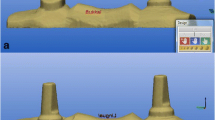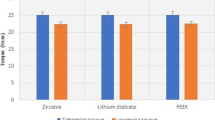Abstract
Aim of this in vitro study was to investigate the effect of artificial ageing and differential abutment support on the load-bearing capacity of zirconia posterior four-unit fixed dental prostheses (FDPs). Thirty-six FDPs were fabricated using CAD/CAM technology and divided into three groups. Specimens in the first group were cemented onto tooth analogues with simulated periodontal resilience, in the second group onto a dental implant and a tooth analogue, but in the third group only onto implants. Half of the samples in each group underwent artificial ageing. Afterwards, all FDPs were loaded until bulk fracture in a universal testing machine. Load-displacement curves and forces at fracture were recorded and results were statistically analysed using ANOVA. Load-bearing capacities within the different test groups averaged as follows (control/artificially aged): tooth–tooth supported (2,009/1,751 N), tooth–implant supported (2,144/1,935 N) and implant–implant supported (2,689/2,484 N). Artificial ageing as well as differential abutment support did have a significant influence on the fracture strength of the zirconia FDPs. Implant-retained prostheses demonstrated the highest load-bearing capacity, while resilient support was demonstrated to be unfavourable. According to these in vitro results, zirconia four-unit prostheses may be promising for application in posterior areas with all three support scenarios (implant-assisted, tooth-retained, or implant–tooth-interconnected prostheses). However, the restorations’ mechanical strength may expected to be significantly influenced in situ by ageing of the material on the long term.






Similar content being viewed by others
References
Hannink R, Kelly PM, Muddle BC (2000) Transformation toughening in zirconia-containing ceramics. J Am Ceram Soc 83:461–487
Anusavice KJ (2007) Dental ceramics. In: Anusavice KJ (ed) Philipps' science of dental materials. Elsevier Ltd., St. Louis, Missouri, pp 655–721
Borchers L, Stiesch M, Bach FW, Buhl JC, Hubsch C, Kellner T, Kohorst P, Jendras M (2010) Influence of hydrothermal and mechanical conditions on the strength of zirconia. Acta Biomater 6:4547–4552
Vagkopoulou T, Koutayas SO, Koidis P, Strub JR (2009) Zirconia in dentistry: part 1. Discovering the nature of an upcoming bioceramic. Eur J Esthet Dent 4:130–151
Papanagiotou HP, Morgano SM, Giordano RA, Pober R (2006) In vitro evaluation of low-temperature aging effects and finishing procedures on the flexural strength and structural stability of Y-TZP dental ceramics. J Prosthet Dent 96:154–164
Swab JJ (1991) Low temperature degradation of Y-TZP materials. J Mater Sci 26:6706–6714
Chevalier J (2006) What future for zirconia as a biomaterial? Biomaterials 27:535–543
Beuer F, Steff B, Naumann M, Sorensen JA (2008) Load-bearing capacity of all-ceramic three-unit fixed partial dentures with different computer-aided design (CAD)/computer-aided manufacturing (CAM) fabricated framework materials. Eur J Oral Sci 116:381–386
Att W, Grigoriadou M, Strub JR (2007) ZrO2 three-unit fixed partial dentures: comparison of failure load before and after exposure to a mastication simulator. J Oral Rehabil 34:282–290
Att W, Stamouli K, Gerds T, Strub JR (2007) Fracture resistance of different zirconium dioxide three-unit all-ceramic fixed partial dentures. Acta Odontol Scand 65:14–21
Kohorst P, Herzog TJ, Borchers L, Stiesch-Scholz M (2007) Load-bearing capacity of all-ceramic posterior four-unit fixed partial dentures with different zirconia frameworks. Eur J Oral Sci 115:161–166
Kohorst P, Dittmer MP, Borchers L, Stiesch-Scholz M (2008) Influence of cyclic fatigue in water on the load-bearing capacity of dental bridges made of zirconia. Acta Biomater 4:1440–1447
Rosentritt M, Behr M, van der Zel JM, Feilzer AJ (2009) Approach for valuating the influence of laboratory simulation. Dent Mater 25:348–352
Dittmer MP, Kohorst P, Borchers L, Stiesch M (2010) Influence of the supporting structure on stress distribution in all-ceramic FPDs. Int J Prosthodont 23:63–68
Kohorst P, Butzheinen LO, Dittmer MP, Heuer W, Borchers L, Stiesch M (2010) Influence of preliminary damage on the load-bearing capacity of zirconia fixed dental prostheses. J Prosthodont 19:606–613
Scherrer SS, de Rijk WG (1993) The fracture resistance of all-ceramic crowns on supporting structures with different elastic moduli. Int J Prosthodont 6:462–467
Rosentritt M, Behr M, Gebhard R, Handel G (2006) Influence of stress simulation parameters on the fracture strength of all-ceramic fixed-partial dentures. Dent Mater 22:176–182
Della Bona A, Kelly JR (2008) The clinical success of all-ceramic restorations. J Am Dent Assoc 139(Suppl):8S–13S
Luthy H, Filser F, Loeffel O, Schumacher M, Gauckler LJ, Hammerle CH (2005) Strength and reliability of four-unit all-ceramic posterior bridges. Dent Mater 21:930–937
Kelly JR, Tesk JA, Sorensen JA (1995) Failure of all-ceramic fixed partial dentures in vitro and in vivo: analysis and modeling. J Dent Res 74:1253–1258
Drummond J (1989) In vitro aging of yttria-stabilized zirconia. J Am Ceram Soc 72:675–676
Palmer DS, Barco MT, Billy EJ (1992) Temperature extremes produced orally by hot and cold liquids. J Prosthet Dent 67:325–327
Kolbeck C, Behr M, Rosentritt M, Handel G (2008) Fracture force of tooth-tooth- and implant-tooth-supported all-ceramic fixed partial dentures using titanium vs. customised zirconia implant abutments. Clin Oral Implants Res 19:1049–1053
Nothdurft FP, Merker S, Pospiech PR (2010) Fracture behaviour of implant-implant- and implant-tooth-supported all-ceramic fixed dental prostheses utilising zirconium dioxide implant abutments. Clin Oral Investig 15:89–97
Gale MS, Darvell BW (1999) Thermal cycling procedures for laboratory testing of dental restorations. J Dent 27:89–99
Schindler HJ, Stengel E, Spiess WE (1998) Feedback control during mastication of solid food textures–a clinical-experimental study. J Prosthet Dent 80:330–336
Dittmer MP, Kohorst P, Borchers L et al (2010) Stress analysis of an all-ceramic FDP loaded according to different occlusal concepts. J Oral Rehabil 38(4):278–285
Dittmer MP, Kohorst P, Borchers L, Stiesch-Scholz M (2009) Finite element analysis of a four-unit all-ceramic fixed partial denture. Acta Biomater 5:1349–1355
Denry I, Kelly JR (2008) State of the art of zirconia for dental applications. Dent Mater 24:299–307
Ahlberg JP, Kovero OA, Hurmerinta KA, Zepa I, Nissinen MJ, Kononen MH (2003) Maximal bite force and its association with signs and symptoms of TMD, occlusion, and body mass index in a cohort of young adults. Cranio 21:248–252
Ferrario VF, Sforza C, Zanotti G, Tartaglia GM (2004) Maximal bite forces in healthy young adults as predicted by surface electromyography. J Dent 32:451–457
Gibbs CH, Mahan PE, Mauderli A, Lundeen HC, Walsh EK (1986) Limits of human bite strength. J Prosthet Dent 56:226–229
Menicucci G, Mossolov A, Mozzati M, Lorenzetti M, Preti G (2002) Tooth-implant connection: some biomechanical aspects based on finite element analyses. Clin Oral Implants Res 13:334–341
Vult von Steyern P, Kokubo Y, Nilner K (2005) Use of abutment-teeth vs. dental implants to support all-ceramic fixed partial dentures: an in-vitro study on fracture strength. Swed Dent J 29:53–60
Acknowledgements
This study was supported by the Institut Straumann AG, Basel, Switzerland, which is gratefully acknowledged.
Conflict of interest
The authors declare that they have no conflict of interest.
Author information
Authors and Affiliations
Corresponding author
Rights and permissions
About this article
Cite this article
Sarafidou, K., Stiesch, M., Dittmer, M.P. et al. Load-bearing capacity of artificially aged zirconia fixed dental prostheses with heterogeneous abutment supports. Clin Oral Invest 16, 961–968 (2012). https://doi.org/10.1007/s00784-011-0569-0
Received:
Accepted:
Published:
Issue Date:
DOI: https://doi.org/10.1007/s00784-011-0569-0




